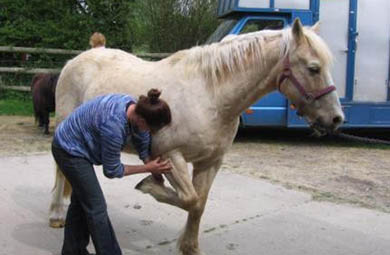Select tab
About
Equine Touch Practitioner Route comprises three practical courses (Foundation; Intermediate and Advanced) each making up a complete Programme of Study covering the following elements:
- Learning the holistic Equine Touch Bodywork (Balances) and Completing Horse Case Studies
- Building a portfolio of evidence showing understanding of:- Equine Touch Knowledge and Application- Equine Anatomy & Physiology.
- Equine Touch Practical Skills Assessment.
On successful completion of each programme, a Lantra Certificate of Achievement is awarded. When all three programmes are completed the Learner can then apply to the Equine Touch Foundation (ETF) to become a licensed Equine Touch Practitioner.
The finer details
The Foundation course is the first of 3 training programmes leading to the Practitioner Accreditation.
This robust route of training and continual assessment is designed to produce dedicated and professionally trained Equine Touch Practitioners who present the modality to the public with professionalism and to the high standards of proficiency required by the Equine Touch Foundation and the general public.
Students on the Practitioner Route are required to show they can do Equine Touch by performing it, writing about it, and cataloguing everything in a Portfolio of Evidence.
Scope of the Foundation Practical Course:
- Students will gain an individual understanding of the Equine Touch and learn the Foundation skill- set to apply to their own horses.
- Learn the Equine Touch move.
Learn a dynamic body balance for the rider.
Learn the full Basic Body Balance for horse – this is the cornerstone ‘whole horse address’ of the Equine Touch and forms the basis of the Equine Touch work.
Learn six key Area of Concern procedures for the horse* – these procedures cover areas that commonly crop up as needing maintenance in most horses irrespective of age or work pattern (e.g. hamstrings, foreleg, middle back) - * Taught during ET Foundation Part II
Home Study Learning and Research
- The Learner must provide evidence of understanding the basic principles behind the Equine Touch move and its correct application.
Anatomy & Physiology - Understanding the hierarchy of the animal body (cell, tissue, organ), skin and fascia plus an introduction to circles of influence: teeth and hooves:
- The Learner must provide evidence of understanding the basic principles of the living body; the anatomy and physiology of the skin and fascia, the two important media addressed by Equine Touch. The Learner should be able to recognise the structural changes in these tissues and understand how Equine Touch can help to restore the normal physiology.
Who should attend?
The Practical Course is suitable for:
- Any person interested in or involved with horses
- Anyone looking for practical skills to help their own horses.
Anyone wishing to offer Equine Touch as a professional service to others or who already has qualifications in other related disciplines and wishes to add to their portfolio of skills for the equine must register on the Practitioner Training Route and complete ongoing practical and theoretical training and assessment in order to gain Lantra certification at the end of each Programme.
What will be covered?
By the end of the course, you will be able to:
Practical
Complete 10 case studies showing competent use of skills learnt and be able to record each session showing due regard for health and safety whilst working around the horse;
Equine Touch Theory
- The importance of Health and Safety for self, others and the equine when working around the horse
- The main principles governing the Equine Touch 'move' and the performance of Equine Touch; The overall aim of an Equine Touch session
- Why it is important to develop a systematic approach to an ET session, how an ET session ensures that this is achieved, and the advantages of this
The frequency with which Equine Touch sessions may/should be performed on a horse, and how this might be determined
- What must be provided for a horse after an Equine Touch session and understand the additional considerations and provisions a horse may find beneficial
- When Equine Touch must not be performed and contraindications to performing Equine Touch
- The behavioural characteristics that the horse exhibits which need to be considered when approaching a horse for an ET session.
Anatomy and Physiology Understand:
- The structure and function of cells
- The connection between specific tissue types, including fascia, and their function in the body; The location and role of Fascia in the body and its’ importance in ET
- The structure and function of ‘Organs’; The structure and action of muscle tissue
- How ET can lead to the detoxification of the body and repair of tissues/organs
- The significance of two elements making up 'the circle of influence’ on the horse’s body and how these may influence the effectiveness of an Equine Touch session - Teeth and Hooves.
For further information visit www.equinetouchuk.com/coursedatesequinetouch or contact the learning support hub on learningcoordinatoretf@gmail.com
Other areas of interest
- Equine Touch Intermediate
- Equine Touch Advanced.
Search for providers near you
If there are no suitable courses listed above, please fill in the details below and this will display a list of other course providers who also deliver this course.



